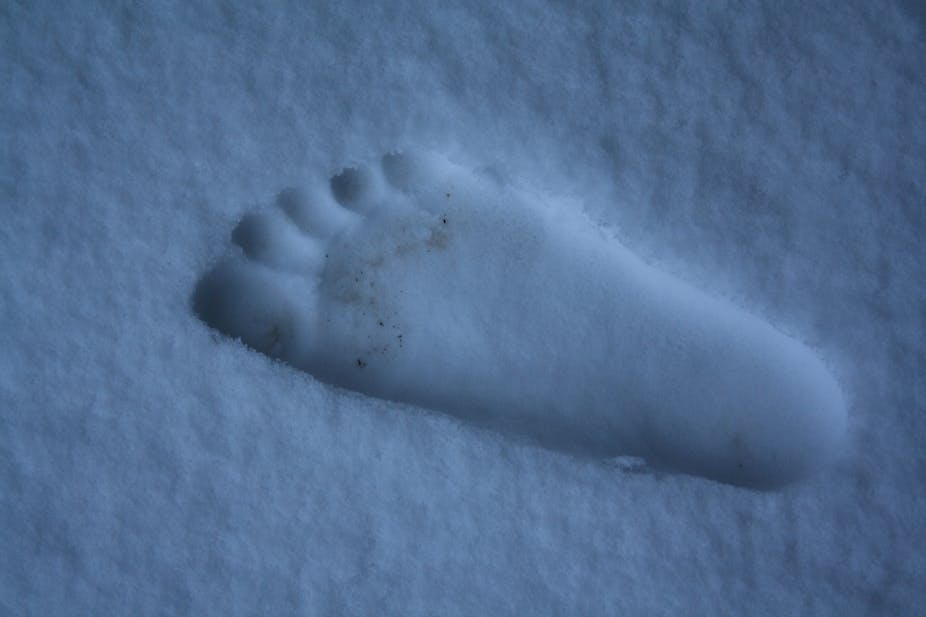The recent DNA testing of two hairs, purportedly from a yeti, has raised a lot of public interest. Does the evidence really show that yetis exist?
Well, not just yet. The test looked at mitochondrial DNA sequences, a commonly used forensic technique that looks at genetic material inherited from the mother only. This is an easier test to conduct because mitochondrial DNA is present in many copies in every cell, so there is more to work with in small or degraded samples.
Critically, the test was conducted in a lab that works primarily on humans, and they produced sequences that, when matched to a database, turned out to be bear-like, specifically polar bear-like. I haven’t seen the data, but I would find this result convincing. If Bryan Sykes, professor of human genetics at Oxford University, had found the DNA to be human there would be question marks due to possible contamination, because a tiny fleck of dandruff can easily contribute spurious DNA.
Accepting that the hair samples came from polar bears, the next question to ask is how they came to be in the Himalayas and associated with the yeti story. Many alternative explanations need to be eliminated before we can take this story seriously. It is possible, for instance, that the hairs got there by accident.
Journalists, explorers and scientists interested in the world’s colder regions may well visit both the Arctic, where polar bears live, and the Himalayas. Could hairs travel between these places either on or even made into clothing or mementos? Possibly. Certainly, if someone found a putative yeti footprint and, when crouching over it, a polar bear hair fell onto the snow, I can imagine a level of excitement where the person forgets what they are wearing.
If the hairs did not get to the Himalayas by accident, then we must consider the possibility that they were placed there deliberately. History is littered with hoaxes, from Piltdown man to the famous photos of the Loch Ness monster. Journalists would be motivated to produce a good story. Locals might like to increase tourism. Rogue scientists might like to take credit for solving a riddle or perhaps even play a joke on colleagues. For a scientific prankster, what better artifact to place than a polar bear hair?
I know nothing about the circumstances in which these hairs were collected, but to take the bear story at face value I would need to see a lot of solid evidence that a spoof was out of the question. Such evidence is not easy to come by.

What if the hairs were not placed there deliberately? Then the story gets more interesting, but it would still be somewhat difficult to swallow. A polar bear could do a good imitation of the storybook yeti. Rearing onto its hind legs it would appear huge and frightening. And bears living in perennially snowy conditions, like most other species, would tend to evolve white fur: prey species don’t want to be discovered while predators need to be able to sneak up on their prey unseen. However, bears are large, warm-blooded species that need a lot of nutrition.
Polar bears survive by eating seals, which are seasonally abundant and provide large chunks of high calorie blubber. A similar species of bear living in the Himalayas would probably find life more difficult. These regions are depicted as barren landscapes not bursting with energy-rich fruits and berries or large, small mammals. From my limited knowledge I struggle to see how such a large species like a polar bear could obtain sufficient nutrition. This is even more of a problem if we are to believe there is a viable population numbering at least tens and probably a few hundred. Why are there not more sightings?
To dismiss all stories of this kind would be wrong. New species of mammal are occasionally discovered, even now, and there is the famous case of Homo floriensis, the so-called “hobbit”, a recently extinct form of human found in Indonesia. However, even these discoveries are open to revision. New research has questioned whether Homo floriensis could be considered different from Homo sapiens.
Nonetheless, everyone likes a good story, so in cases like the yeti we need to be particularly careful that all the pieces add up. I can be convinced the reported hairs came from bears. I would take a lot more convincing that they came from yeti footprints and that there is a viable but previously unknown population of bears in the Himalayas.

